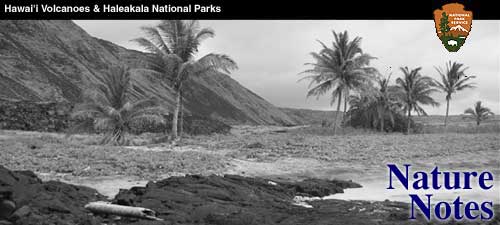

|
|
HAWAII NATURE NOTES
DEDICATION To Mr. Eugene Horner, Member of the Board of Directors of the HAWAII NATURAL HISTORY ASSOCIATION, whose interest in Hawaiian ferns has extended over more than half a century, and whose enthusiasm and willing assistance in collecting and identifying ferns has been of invaluable help, this booklet is dedicated.
Ferns are among the most interesting plants in the plant world. Varieties in Hawaii range from dainty filmy ferns less than one inch in length to stately tree ferns over 40 feet high, and inhabit areas varying from dry, barren lava flows to impenetrable rain jungles. More primitive than flowering plants, ferns reproduce by means of small, dust-like bodies called spores. These spores are often carried in the air, and are so lightweight that they can be blown for thousands of miles by winds. The ferns of Hawaii, or their ancestors, apparently reached these islands with the help of winds, except for those introduced recently by man.
Hawaii National Park belongs to the American people. When it was set aside by Congress in 1916 the three volcanoes, Haleakala, Mauna Loa, and Kilauea were of principal interest. It has become increasingly apparent that the beautiful forests of native trees, the birds which depend upon Hawaiian plants for survival, and the magnificent fern jungles are of equal importance and more in need of protection. Outside of the park, trees such as the koa (Hawaiian mahogany) and the ohia are being cut for lumber, and tree ferns, upon whose trunks orchids are grown, are rapidly being taken for this expanding industry. The National Park Service has been given the responsibility of keeping its areas in as nearly an original condition as possible—a little bit of America, unspoiled. Hawaii National Park—your park—is among the most outstanding of these. Please help us keep it this way.
This booklet is not intended to be a comprehensive treatment of all the ferns—some 70 species—which have been found to date in Hawaii National Park. Rather it is an illustrated guide to the more abundant species which may be seen by the visitor without wandering far from the beaten path. Abundance has been used as the basis for arrangement, instead of scientific classification, and illustrations take the place of technical descriptions. The more serious observers are referred to the selected bibliography near the end of this publication. Some disagreement exists today among botanists as to the proper scientific names for certain Hawaiian plant species, and many ferns have been undergoing reclassification. For this reason all of the scientific names that could be found for the various ferns in this booklet have been listed on pages 37, 38 and 39. A brief code has been included to indicate the type of habitat in which the ferns normally may be found: D=dry, M=moist, D&M=dry and moist. Numbers in bold-face type are used for that particular fern throughout the publication. The page numbers refer to the location of the text and the scientific name for that species. One inch squares are used for background scale in many of the illustrations. All photographs are by the author unless otherwise credited.
|
| <<< Previous | > Cover < | Next >>> |
nature_notes/havo/vol5-1a.htm
24-Mar-2006